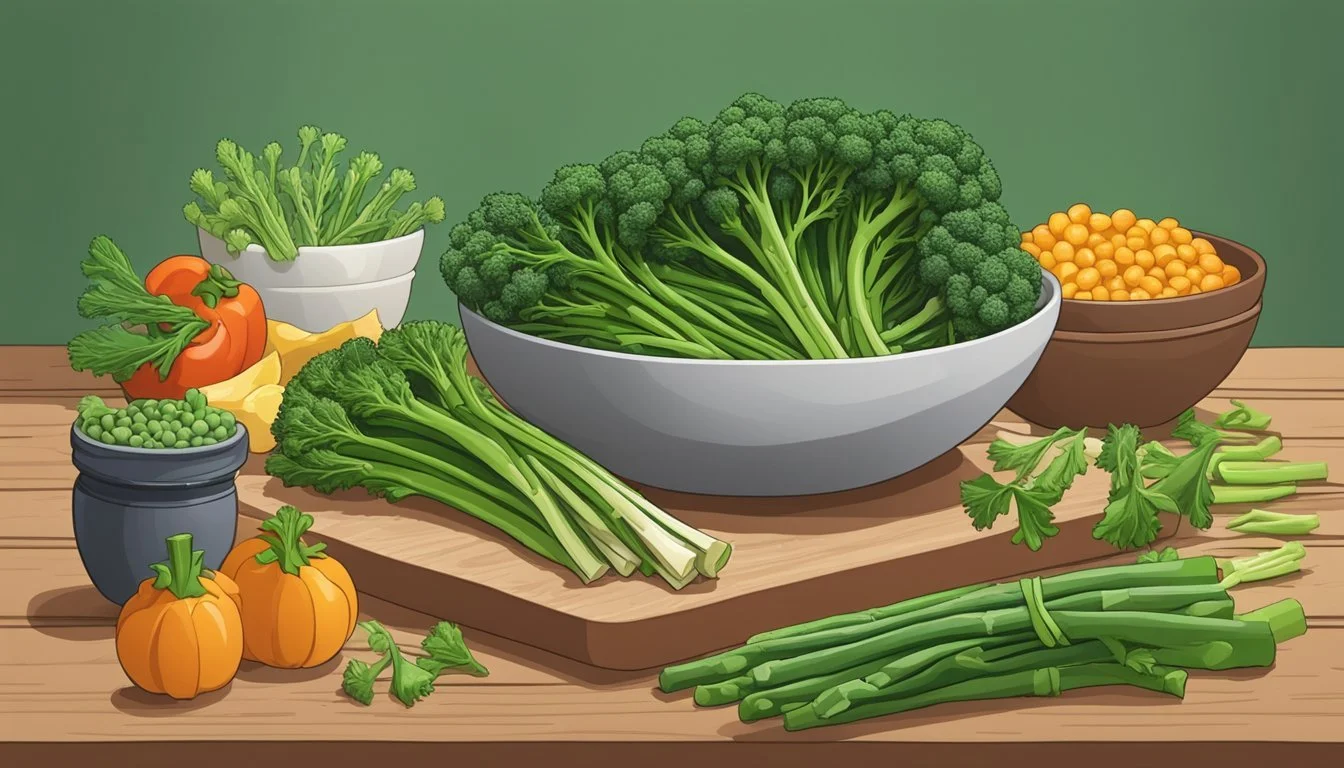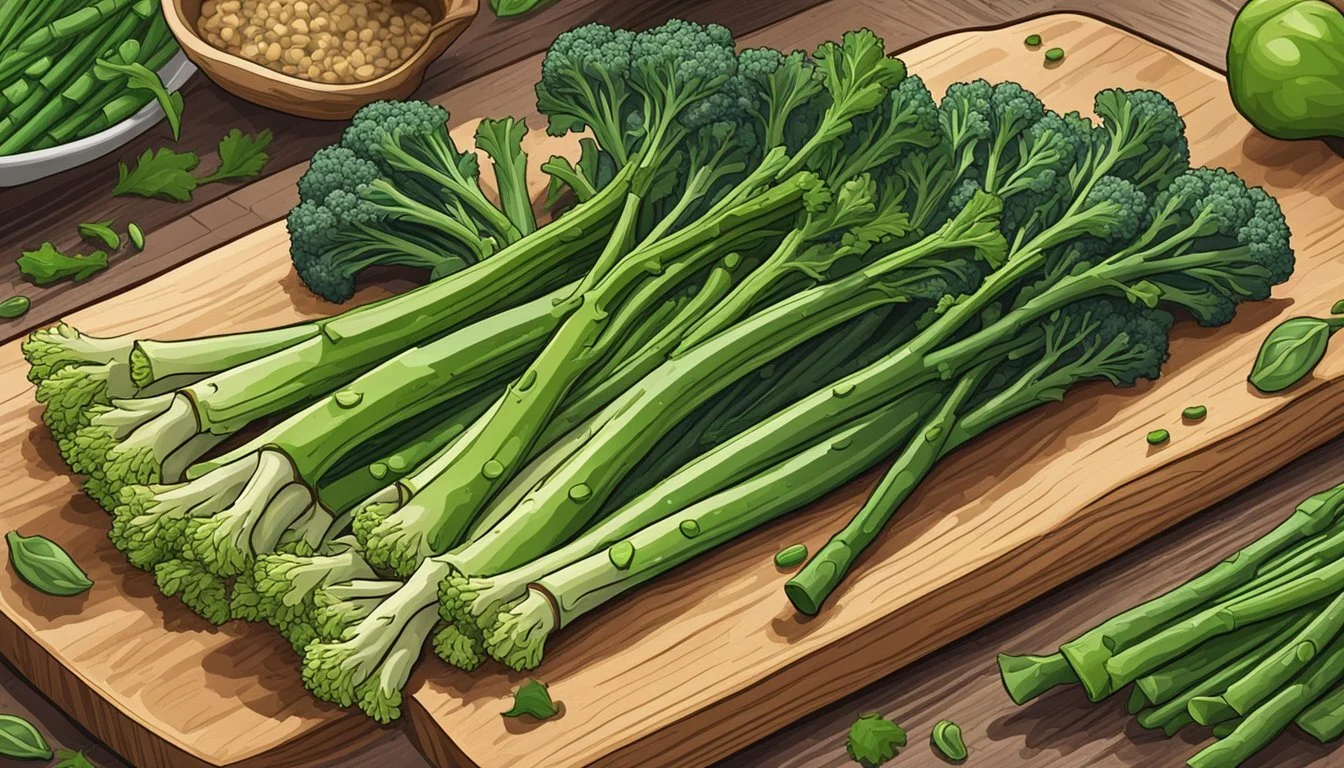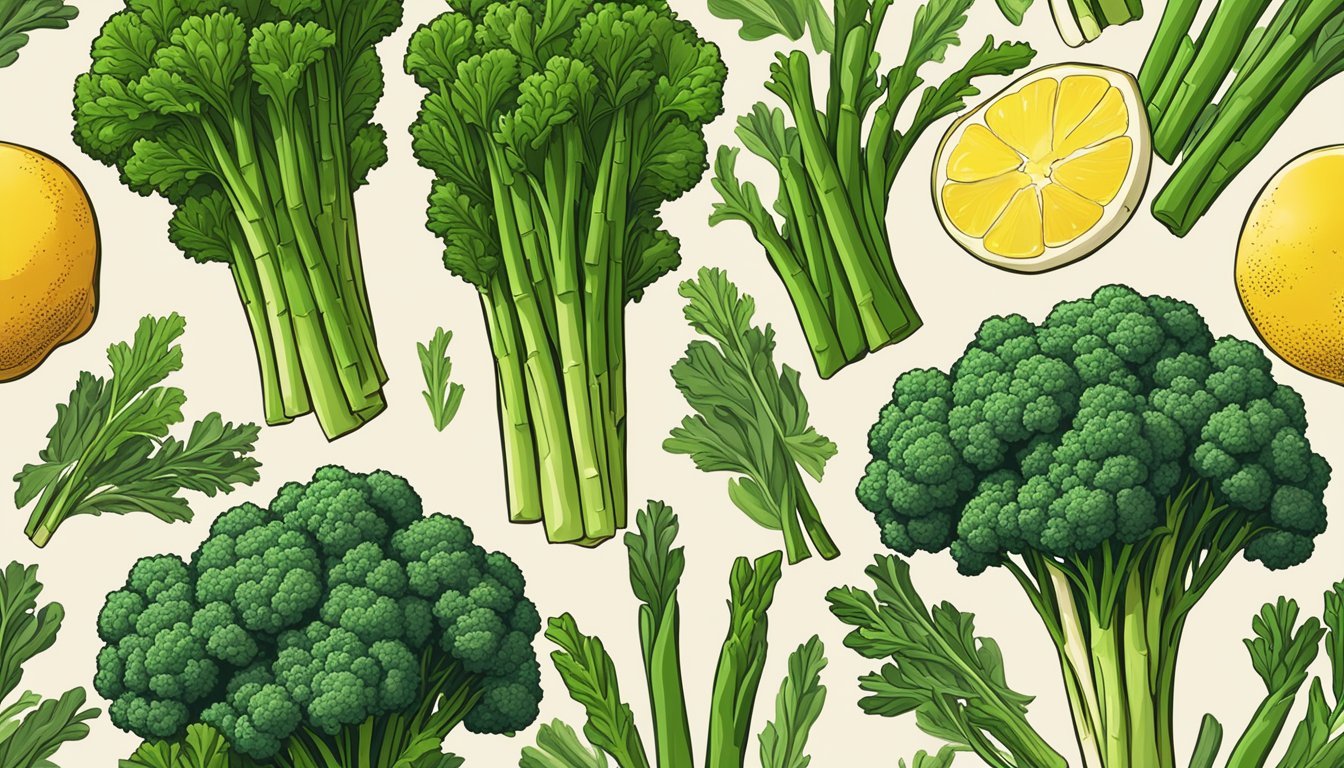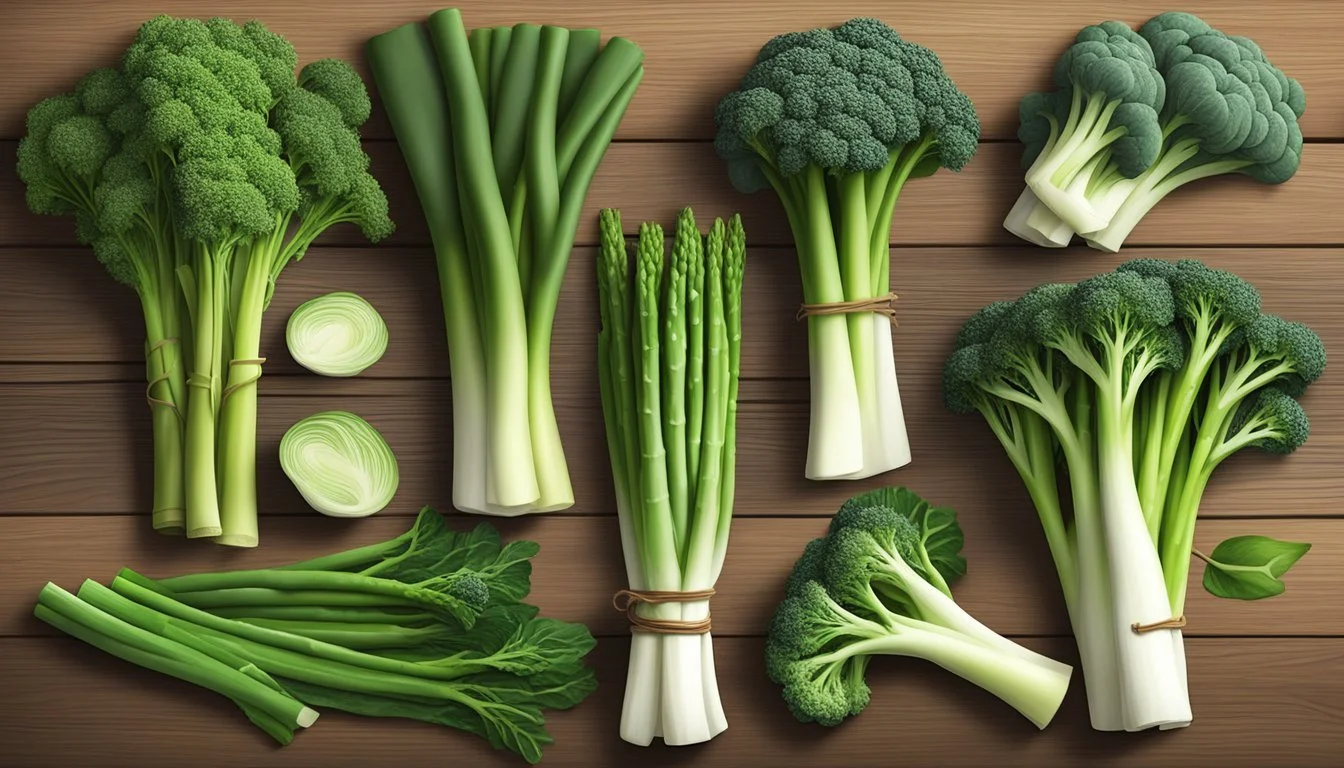Broccolini Substitutes
Best Alternatives for Cooking
Broccolini, a popular hybrid vegetable known for its tender stalks and mild flavor, often finds itself at the center of many delightful dishes. However, when broccolini is not available, several alternatives can seamlessly step in without compromising the taste and texture of your meal. For those searching for a substitute, broccoli, Swiss chard, bok choy, asparagus, cauliflower, and kale are excellent options.
Broccoli, closely related to broccolini, offers a similar crunch and slightly bitter taste, making it an ideal replacement. Swiss chard's robust, green leaves can bring a different dimension to pasta dishes and sautés, while bok choy provides a mild sweetness that complements various recipes. Asparagus stands out with its compatibility in stir-fries and as a side dish.
For a milder taste, cauliflower can mimic broccolini's appearance and texture, though attention is needed to avoid overcooking. Kale, with its earthy and slightly bitter flavors, can substitute broccolini in many dishes, although the texture will vary slightly. These substitutes ensure that your culinary creations remain vibrant and flavorful, even in the absence of broccolini.
Understanding Broccolini
Broccolini is a culinary delight known for its unique flavor and versatility. This hybrid vegetable boasts a vibrant green color and crisp texture. Its nutritional value and culinary applications make it a popular choice in kitchens around the world.
Characteristics of Broccolini
Broccolini is a hybrid between broccoli and Chinese broccoli (gai lan). It features long, slender stems topped with small florets and dark green leaves. Unlike traditional broccoli, broccolini has a more tender stem which does not require peeling. The flavor is milder and sweeter, making it appeal to those who find regular broccoli too assertive. Its vibrant green color remains intact even after cooking, adding visual appeal to dishes.
Nutritional Profile
Broccolini is not just visually appealing; it packs an impressive nutritional punch. It is a good source of fiber, which aids in digestion. It contains several vitamins including A, C, and K, contributing to immune function, skin health, and blood clotting. Additionally, broccolini delivers essential minerals such as calcium and iron, supporting bone health and oxygen transport. Antioxidants present in broccolini help combat oxidative stress. With some protein content, this vegetable contributes to a balanced diet.
Culinary Uses
Broccolini’s versatility shines in various culinary applications. It can be roasted, steamed, or sautéed. When roasted with a drizzle of olive oil, it develops a slightly crispy texture. Steaming retains its bright color and nutrients, while sautéing with garlic adds a flavorful punch. Broccolini works well in pasta dishes, adding both texture and taste. It's also a great addition to stir-fries and salads, providing a nutritional boost. As a side dish, it pairs well with a variety of main courses, from meat to seafood.
By knowing its characteristics, nutritional benefits, and culinary uses, one can fully appreciate broccolini's place in a healthy, delicious diet.
Common Substitutes for Broccolini
When broccolini is unavailable or you're looking to try something different, several vegetables can serve as excellent substitutes. These substitutes maintain similar taste profiles, textures, and versatility in various recipes.
Broccoli
Broccoli is a readily accessible substitute for broccolini. It has a slightly milder flavor, but its texture is quite similar when cooked. Both vegetables belong to the cabbage family and can be prepared in the same ways. For example, roasting, steaming, or sautéing broccoli will yield results comparable to broccolini.
The florets and stems of broccoli can be used in dishes like salads, stir-fries, and pastas, providing a nutrient-rich alternative. Broccoli rice, a popular low-carb substitute for regular rice, also highlights its versatility. This makes broccoli a dependable replacement in many recipes requiring broccolini.
Chinese Broccoli (Gai Lan)
Chinese Broccoli, or Gai Lan, offers a leafy green option with a slightly bitter flavor. It is quite versatile and can be used in a range of dishes, from stir-fries to soups. Gai Lan’s stems are thicker and less tender than broccolini's, but when cooked properly, they become delightfully crunchy and flavorful.
Steaming or boiling Gai Lan helps mellow its bitterness, making it more palatable for those who are sensitive to stronger flavors. Often used in Asian cuisines, it pairs well with garlic, soy sauce, and oyster sauce, adding both nutritional value and a unique taste to your meals.
Broccoli Rabe (Rapini)
Broccoli Rabe, or Rapini, is another viable substitute with a distinctly bitter and earthy flavor. Although it looks similar to regular broccoli, its taste and nutritional profile are closer to broccolini. Broccoli Rabe is highly versatile, fitting well into Italian dishes, soups, and pasta recipes.
Its leafy greens and slender stalks make it an excellent addition to sautéed vegetable medleys or as a side dish. To reduce its bitterness, blanch the rapini before using it in your recipes. This technique enhances its texture and flavor, making it a suitable alternative for broccolini.
Leafy Green Alternatives
Leafy green vegetables like kale, spinach, Swiss chard, and collard greens serve as excellent substitutes for broccolini. These alternatives offer a mix of flavors and textures while being rich in various nutrients essential for health.
Kale
Kale is a cruciferous vegetable known for its firm texture and slightly bitter taste. It is packed with vitamins A, C, and K, making it a nutritious choice. The leafy green vegetable can be sautéed, steamed, or added to soups and stews.
Kale's sturdy leaves hold up well in cooking, making it suitable for hearty dishes. When using kale as a substitute for broccolini, it's best to remove the tough stems and chop the leaves finely.
Spinach
Spinach, particularly baby spinach leaves, provides a milder flavor compared to broccolini. This leafy green is rich in iron and vitamin C, contributing to a healthy diet.
The tender leaves of spinach cook quickly and can be used in a variety of dishes such as salads, soups, and pasta. Spinach can be steamed or sautéed, offering a versatile option that pairs well with different ingredients.
Swiss Chard
Swiss chard is another excellent alternative, with its colorful stems and leaves that add visual appeal to any dish. It has a mild, slightly bitter flavor and is high in minerals and vitamins, including vitamin K.
When preparing Swiss chard, it is important to remove the tough stems and chop the leaves. This leafy green vegetable works well in sautés, soups, and side dishes, providing a tender texture that complements many recipes.
Collard Greens
Collard greens, a staple in Southern cuisine, have a firm texture and a slightly bitter taste. They are rich in vitamins A, C, and K, and provide a significant amount of dietary fiber.
To use collard greens as a broccolini substitute, the leaves should be sliced thinly and cooked longer to achieve the desired tenderness. They can be braised, steamed, or added to stews and casseroles, making them a versatile and hearty option.
Other Vegetable Substitutes
When broccolini isn't available, there are several other vegetables that can effectively take its place. These alternatives maintain similar flavors and nutritional benefits, and each offers unique characteristics that can enhance various recipes.
Asparagus
Asparagus is a highly versatile vegetable known for its slightly sweet flavor and tender texture. It can be grilled, roasted, or steamed, adapting well to a wide range of dishes.
This vegetable cooks quickly, making it a great addition to stir-fries, pastas, and salads. Asparagus is rich in vitamins A, C, and K, and provides dietary fiber that supports digestive health. When substituting for broccolini, adjust the cooking time to prevent the asparagus from becoming too soft.
Cauliflower
Cauliflower, a member of the cruciferous vegetable family, is another excellent substitute. Its mild taste and ability to absorb flavors make it adaptable in many recipes.
Roasting brings out a sweet, nutty flavor, while steaming or sautéing maintains its firm texture. Packed with nutrients such as vitamin C and folate, cauliflower also provides significant dietary fiber. It works well in casseroles, soups, and as a pureed base for sauces, delivering both versatility and nutrition.
Brussels Sprouts
Brussels sprouts, closely related to broccolini in the cruciferous vegetable family, offer a robust and slightly nutty taste. These small, leafy vegetables are best when roasted or sautéed to develop a caramelized exterior.
Rich in vitamin K, vitamin C, and dietary fiber, Brussels sprouts contribute to a nutritious diet. They also add a burst of flavor and crisp texture to dishes. When using them as a substitute, halve or quarter them to ensure even cooking.
Green Beans
Green beans are a crisp, sweet vegetable that makes a great broccolini substitute. Their vibrant color and crunchy texture complement various dishes, from stir-fries to salads.
Steamed, sautéed, or roasted, green beans maintain their firm bite and add a fresh burst of flavor. They are high in fiber, vitamins K and C, and other essential nutrients. Adjust cooking methods to keep them tender yet not overly soft, matching the texture you desire in your dish.
Unique Alternatives
Discovering unique alternatives to broccolini can diversify your culinary repertoire. The following vegetables offer interesting textures and flavors that can complement various dishes.
Bok Choy
Bok choy, a staple in Asian cuisine, boasts a mild, slightly sweet flavor. This versatile leafy green works well in stir-fries, soups, and salads.
Its crisp stalks and tender leaves provide a delightful contrast when sautéed with garlic and ginger. Bok choy's ability to absorb flavors makes it a fantastic choice for savory dishes.
Rich in calcium and vitamins A and C, bok choy also offers nutritional benefits. It is particularly effective when cooked briefly to maintain its texture and nutrients.
Cabbage
Cabbage brings a combination of sweetness and earthiness to dishes. Its robust, crunchy texture holds up well in a variety of cooking methods.
This vegetable can be sliced thin for salads, cooked in stir-fries, or even fermented to create sauerkraut. Cabbage's versatility extends from raw applications to braising and roasting.
Nutritionally, cabbage is rich in vitamin K and vitamin C, making it a healthy addition to meals. Its unique flavor can bring new dimensions to your dishes, especially in vegetable medleys.
Turnip Greens
Turnip greens, a lesser-used option in many kitchens, offer a slightly bitter taste that can add complexity to meals. They're popular in Southern cuisine, often cooked with ham hocks or bacon.
These greens are packed with calcium and vitamins A and C. Turnip greens can be sautéed, steamed, or boiled, making them a flexible ingredient in various recipes.
Their bitterness mellows when cooked, blending well with other flavors in a dish. Adding turnip greens to soups and stews can enhance the depth and richness of the meal.
By incorporating these unique alternatives, you can expand your culinary horizons while enjoying nutritious and flavorful dishes.
Cooking with Substitutes
In the realm of cooking, various broccolini substitutes can bring unique flavors and textures to dishes like pasta, soups, and stir-fries. Each substitute may require adjustments in cooking methods to retain their best qualities.
Adjusting Cooking Methods
When using substitutes for broccolini, altering cooking techniques is essential. For example, asparagus can be roasted with garlic and olive oil, creating a burst of flavor and a crisp texture.
Kale is better suited for sautéing with a bit of olive oil until tender.
Cauliflower, on the other hand, requires careful control of cooking time to prevent it from becoming overly soft. Blanching cauliflower before roasting can help maintain a firmer texture, suitable for pasta dishes or as a side in stir-fry.
Flavor Pairings
Pairing flavors correctly can enhance the taste of broccolini substitutes. Broccoli shares a similar slightly bitter flavor with broccolini and works well with sauces containing garlic and soy, making it perfect for stir-fries.
Swiss chard offers a sweeter flavor when sautéed, which pairs nicely with balsamic vinegar and garlic.
Broccoli rabe has a bold, slightly bitter taste that mellows when cooked with chili flakes and lemon juice, fitting well into soups and hearty stews.
Texture Considerations
Texture significantly impacts how substitutes can be used in recipes. Asparagus provides a satisfying crunch, making it suitable for dishes that benefit from a firmer texture, such as stir-fries.
Cauliflower and broccoli, both having firm stems, offer a satisfying crunch when roasted or sautéed.
Kale and Swiss chard have a more tender texture when cooked, making them better suited for incorporation into soups and as softer elements in stews.
Considering these textural differences ensures that each substitute is used to its best potential, adding variety and interest to meals.
Health Considerations and Nutritional Comparisons
When choosing a substitute for broccolini, it's crucial to compare nutritional values and consider potential dietary restrictions or allergies. This section will examine essential nutrients and dietary considerations between broccolini and its common substitutes.
Comparing Essential Nutrients
Broccolini and its substitutes like broccoli, asparagus, and kale are rich in vitamins, minerals, and antioxidants. Broccolini contains higher levels of lutein and zeaxanthin, beneficial for eye health. It also has more phosphorus, manganese, and calcium than broccoli, which can support bone health.
Broccoli offers similar nutritional benefits but has a higher vitamin C content, which is essential for immune function. Asparagus is another good substitute, providing a unique profile rich in dietary fiber and vitamin K. Kale, often considered a superfood, stands out for its high iron and vitamin A content.
Nutrient Broccolini Broccoli Asparagus Kale Calcium High Moderate Low High Vitamin C Moderate High Moderate Low Iron Low Low Moderate High Antioxidants High High Moderate High Dietary Fiber Moderate High High High
Allergy and Dietary Restrictions
When substituting broccolini, understanding dietary restrictions and potential allergies is vital. Broccoli, broccolini, and kale belong to the Brassicaceae family, so those with allergies to cruciferous vegetables should be cautious.
Asparagus is not part of the cruciferous family, making it suitable for those with specific allergies. However, some people may experience allergic reactions to asparagus, although it's less common.
For individuals following specific diets like low FODMAP, broccoli and broccolini in large amounts can cause digestive issues due to high levels of fermentable carbs. Asparagus also contains FODMAPs but in different quantities. Kale is usually well-tolerated but should be consumed in moderation by those with thyroid issues due to its goitrogen content.
Availability and Selection
Broccolini substitutes offer diverse flavors and textures, and their availability varies by region and season. Selecting the best substitute involves understanding the specific taste profiles and firmness required for your dishes.
Seasonality and Locale
Substitutes like asparagus, Swiss chard, and bok choy are generally available year-round in supermarkets, especially in larger cities across the US and Japan. Asparagus is often favored in spring, boasting a vibrant green color and a firm texture.
Swiss chard peaks in summer but can be found year-round. It’s known for its slightly bitter taste and crisp leaves.
Choosing the Best Substitutes
When choosing a substitute for broccolini, consider the dish's requirements. Asparagus works well in roasted and sautéed dishes due to its firm texture and ability to caramelize. Swiss chard is ideal for pastas and stews, bringing a slight bitterness and tender leaves.
Cauliflower offers a milder flavor and can be used cup-for-cup in recipes, but watch for overcooking. For a milder, yet crunchy option, bok choy is excellent in stir-fries and soups. Each of these options adds its unique touch while maintaining versatility in preparation methods.








